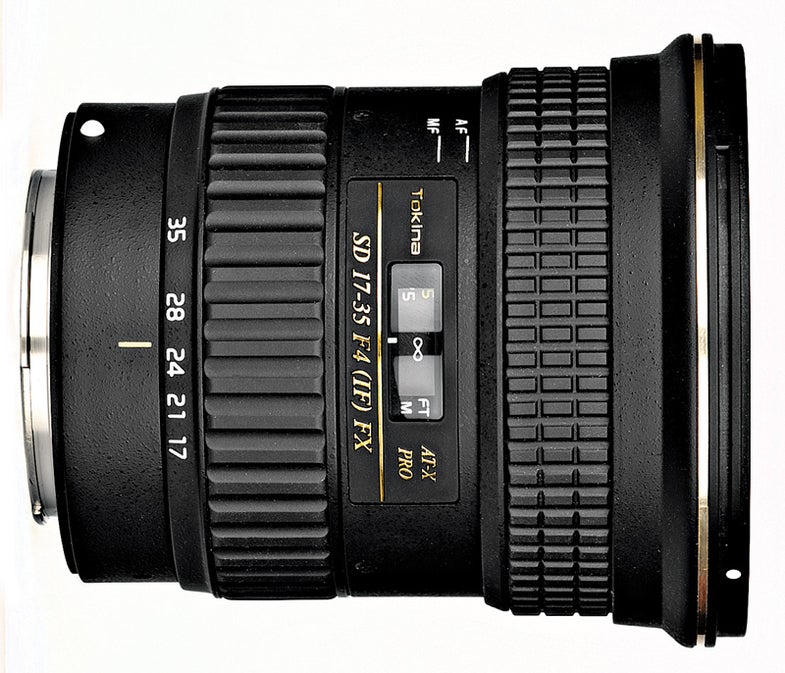Lens Test: Tokina 17–35mm f/4 AT-X PRO FX
Tokina challenges Canon’s and Nikon’s ultrawide f/4's

We may earn revenue from the products available on this page and participate in affiliate programs. Learn more ›
Designed to compete with the popular, ultrawide f/4 full-framers from Canon (17–40mm f/4L; $800, street) and Nikon (16–35mm f/4 VR; $1,140, street), this Tokina 17–35mm f/4 ($720, street) is a welcome constant-aperture zoom for pros and enthusiasts alike.
It offers two elements of SLD glass for improved control of chromatic aberration and an aspheric element for compactness. With new seals around its moving switches and rings, it promises better moisture resistance than most AT-X lenses. It is available only in Canon and Nikon mounts.
In weight, the Tokina sits midway between the 16-ounce Canon and 25-ounce Nikon. While it is more compact that those lenses, it still seems bulky, with a larger front element that accepts 82mm filters, as opposed to the more common 77mm.
This matte black lens has well-ribbed zoom and focus rings that turn smoothly and evenly; the distance scale for focus is highly legible. It also sports Tokina’s push/pull focusing clutch that shifts between auto and manual modes—a bit old-fashioned when compared to today’s lenses that let you manually focus in the AF mode. Tokina did improve the barrel markings: On older models, when the lens was in the unmarked manual-focus position, the push/pull ring would cover the AF marking; newcomers unfamiliar with this collar could easily spend an afternoon adjusting camera buttons while waiting for the AF motor to kick in. With this new lens, an MF marking shows when it’s in manual focus.
On our optical bench, the Tokina pulled down Excellent-range SQF numbers for sharpness and contrast at the three tested focal lengths. The scores often matched the comparable Nikon’s at 11×14 (our benchmark), and were slightly—though not significantly—below the comparable Canon’s, especially at 24mm.
In DxO Analyzer 4.0 tests of the Tokina’s ability to control distortion, it performed admirably at all three tested focal lengths, especially at 24mm and 35mm. But even at 17mm, it outshined both the Canon and Nikon—and the former by a significant margin.
We found no light falloff in the Tokina’s corners at 35mm, and what little we detected at the other two focal lengths vanished by f/5.6 (17mm) and f/5 (24mm), a performance slightly better than the Nikon and noticeably better than the Canon, which showed falloff until f/5.6 at all focal lengths.
In subject magnification, the Tokina proved less outstanding. Both Canon’s (1:3.64 at 40mm) and especially Nikon’s (1:3.33 at 35mm) lenses outperformed it handily.
Are you a serious, full-frame Canon or Nikon shooter seeking entrée to ultrawide realms? You should strongly consider this quiet, fast-focusing zoom for its attractive price, effortless handling, and top-drawer optics.
SPECIFICATIONS
17–35mm (17.35-34.00mm tested), f/4 (f/3.83–4.18 tested), 13 elements in 12 groups. Focus ring turns 80 degrees. Zoom ring turns 60 degrees. Focal length marked at 17-, 21-, 24-, 28-, and 35mm.
Diagonal view angle: 103–64 degrees.
Weight: 1.41 lbs. Filter size: 82mm.
Mounts: Canon AF, Nikon AF.
Included: Lenshood.
Street price: $720.
Website: thkphoto.com
TEST RESULTS
Distortion: At 17mm, 0.40% (Visible) barrel. At 24mm, 0.05% (Imperceptible) pincushion. At 35mm, 0.06% (Imperceptible) pincushion.
Light falloff: At 17mm, gone by f/5.6. At 24mm, gone by f/5. At 35mm, none.
Close-focusing distance: 9.62 inches.
Maximum magnification ratio: At 17mm, 1:7.31. At 24mm, 1:5.52. At 35mm, 1:4.02.
